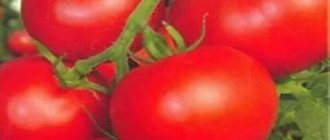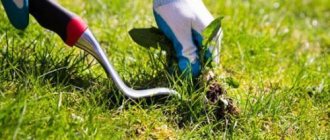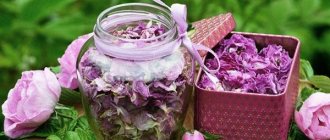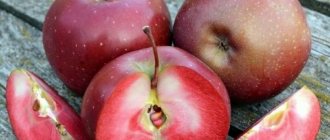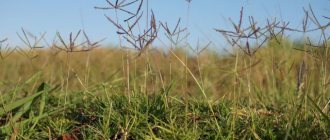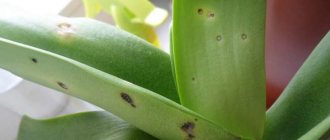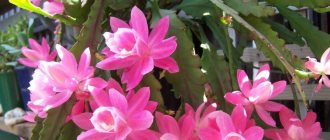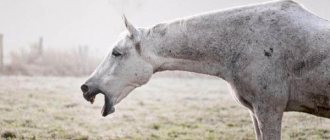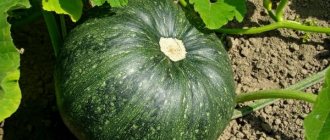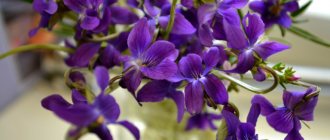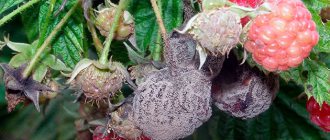Honey-bearing herbs and flowers
A huge variety of honey-bearing herbs and flowers are known. Among them there are both annual and perennial representatives. Among such diversity, particularly important species should be highlighted.
Table of honey plants in central Russia and other regions:
Heather
This flowering plant is an autumn honey plant. Up to 100 kg of honey is collected from one hectare.
Heather honey is characterized by a dark reddish or brownish color, a bitter taste and a strong aroma.
Due to the high content of protein substances, the product does not crystallize during long-term storage, but coagulates to a jelly state. After pumping, it immediately takes on the consistency of jelly.
Heather honey is useful for colds, urolithiasis and cystitis.
Buckwheat
This herbaceous crop is called seed, common or edible. It is placed in first place among honey plants in most Russian regions.
Under favorable conditions, one hectare sown with buckwheat can provide up to 80 kg of honey. Such an area requires 2-3 bee colonies. Insects collect raw materials throughout August.
The flowers of the plant provide bees with nectar and greenish-yellow pollen in large quantities.
Buckwheat honey is characterized by a dark color and a special taste. The composition of the product is rich in iron and has high antiseptic properties.
Sweet clover
White and yellow sweet clover are valued as honey plants. The plant is attractive for its long flowering, which begins in July and ends only at the end of autumn.
Sweet clover is capable of producing up to 600 kg of honey per hectare. Sweet clover honey is distinguished by its light color, delicate consistency, pleasant aroma and excellent taste.
The fresh product has a light watery color. It quickly crystallizes, becoming white or light amber and having a subtle vanilla aroma.
Sweet clover honey is rich in glucose, beneficial for the central nervous system, and is a stimulator of lactation.
goldenrod
This herbaceous plant is a late summer or autumn honey plant.
It is highly valued for providing a winter supply of pollen and honey. The plant's honey productivity is moderate - one hectare of plantings can produce up to 120 kg of honey.
The product may be dark yellow or light brown with a red tint. Goldenrod honey has a unique aroma and bitter taste.
Due to its healing properties, the product is used in the treatment of bladder, liver, and dermatitis.
Ivan-tea (fireweed)
This herbaceous perennial is a summer honey plant.
Its honey productivity can be up to 600 kg per hectare. Fireweed blooms in June-July and lasts about 40 days.
Honey is transparent, greenish in color and has a delicate aroma. Crystallizes to a white creamy mass.
Turns yellow when heated. In folk medicine, the product is valued for its soothing and anti-inflammatory properties.
Clover
This plant is one of the best honey plants. Its productivity can reach 200 kg per hectare.
The main flowering period is observed in June-July. The product obtained from clover is attractive with its rich amber color and strong aroma. Its consistency is viscous.
Coriander
The product obtained from this herbaceous annual is called coriander or calander. The plant is a summer honey plant and usually blooms in June.
From one hectare you can get up to 200 kg. Coriander honey is transparent and may have a light brown or amber color. The aroma characteristics of the product depend on the variety.
Due to the high content of essential oils, the smell of the product is spicy and pungent.
Honey has a specific taste, it has a medicinal caramel aftertaste. Coriander honey has many healing properties.
It is good for digestion, treats gastrointestinal diseases, and restores appetite. The product has antiseptic, analgesic and bronchodilator properties.
Dandelion
This herbaceous perennial is called ordinary, field, medicinal, and pharmaceutical. An average of 4.5 kg of honey can be collected from one hectare.
Flowering occurs mainly in May-June. Dandelion honey is thick and golden yellow in color.
The product crystallizes quickly, has a strong odor and a peculiar pungent taste.
Dandelion honey has no commercial value - bees eat it in the spring. The product is also a feed additive for adult insect brood.
Sow thistle
This herbaceous perennial is called field, yellow, euphorbia.
The plant is considered a weed and blooms in summer and autumn. Thistle is characterized by high honey productivity - about 400 kg of product can be collected from one hectare.
Thistle honey has a white or light yellow color and a pleasant taste. The product is first class.
Thistle honey is valued for its nutritional properties. In folk medicine it is most often used as a remedy for exhaustion, especially in the postoperative period in children and the elderly.
Sunflower
This herbaceous annual is a source of not only seeds, but also honey. Up to 50 kg of product is collected from one hectare. Flowering lasts an average of 30 days and occurs in July-August.
One should distinguish annual sunflower from tuberous sunflower, although it is also a honey plant.
In liquid form, the product has excellent taste. Sunflower honey quickly crystallizes, acquiring a light amber color.
Sometimes a greenish tint is observed. Crystallized honey has a faint aroma and a pleasant taste with tart notes.
Sunflower honey has high enzymatic activity. It has valuable dietary qualities, restorative and diuretic properties.
Rape
This herbaceous annual is an early spring honey plant when sown in autumn.
Winter rapeseed provides honey productivity of 60-90 kg per hectare. Rapeseed honey has a whitish or yellowish color, a very sweet taste and a special aroma.
The density of the product is very high, it crystallizes quickly. The process of crystal formation can begin already in the honeycomb.
The resulting crystals have a white color, a persistent floral aroma and a tart taste. Rapeseed honey requires special storage conditions, as it can quickly turn sour.
The product is high in glucose, which is good for brain activity. Rapeseed honey is good for bone structures and the liver, and helps remove heavy metals from the body.
Common bruise
This herbaceous plant is a valuable summer honey plant. One hectare can produce up to 800 kg of honey. The product obtained from an ordinary bruise is first-class.
It is distinguished by its light or light amber color. The product has a pleasant taste and faint aroma.
Honey has a thick consistency and crystallizes slowly, resulting in the formation of a fine-grained deposit.
Honey from common bruise is good for the cardiovascular system and has a calming effect.
Phacelia
This herbaceous annual is one of the best honey plants.
One hectare of crops can provide half a ton of honey. With proper sowing organization, flowering continues almost all summer.
The product obtained from this plant has a sweet, tart and spicy taste. The color can be different - pale yellow, pale green or pale blue.
When thickened, the mass usually has a white color and a dough-like texture. This honey contains many vitamins and microelements.
Most of all it contains potassium, chromium, calcium, zinc, manganese, cobalt and silver.
Clean
This herbaceous plant is also popularly called toadweed. It is an early spring honey plant. Bees willingly fly to this plant.
From one hectare you can get up to 15 kg of product.
What blooms in Siberia
Siberia is cold, so common plants do not grow there, but other honey plants can be found:
- Rebrocarp Ural . Grows in forests. Productivity up to 180 kg.
- Thistle is a swamp . A perennial plant, but the quality of the honey is slightly lower than usual (not marketable). But the taste is good.
- Yellow acacia . One of the first honey plants in the world, it was used back in the 17th century. Nowadays they are used less often, because there are many other, better quality crops for bribes, and the plant is not very common. Productivity up to 100 kg.
Honey bushes and trees
Among plants of this type, honey plants are usually shrubs or small trees. Their distinctive feature is that they are all perennials.
Barberry
This honey plant usually grows as a shrub; trees are less common.
Provides large amounts of nectar in May-June.
From one hectare you can collect up to 80 kg of product. Honey productivity from such an area is more than 23 kg.
Barberry honey has a light yellow color and a delicate and sweet taste. The aroma contains notes of spring flowers. The product has a medium viscosity.
Barberry honey has many healing properties. It is beneficial for the stomach and intestines, the genitourinary system, and provides an antibacterial effect.
The product perfectly tones and has anti-inflammatory properties.
Hawthorn
Such trees and shrubs belong to late spring honey plants and are attractive to bees. Their honey productivity is moderate and can be up to 80 kg per hectare.
Hawthorn flowering lasts only a week and a half - at the end of spring and the very beginning of June. During this period, the plant emits an unpleasant odor, which insects do not pay attention to.
Hawthorn honey is dark in color with a reddish tint and has a slightly bitter taste. The product is highly valued for its healing properties, it is especially useful for the cardiovascular system.
Cowberry
This evergreen shrub provides support for bees.
From one hectare of plantings you can get up to 50 kg of honey. Flowering lasts approximately 2 weeks and begins at the end of May. Lingonberry honey is a natural medicine.
Vatochnik
This bush is capable of producing up to 700 kg of honey per hectare.
One bee colony can collect more than 5 kg of nectar from this plant per day. It begins to bloom at the end of June. Cottonweed honey has a special aroma and delicate taste.
The color is very light, sometimes yellowish. When pumping in dry weather, the product is heated due to its heaviness and thickness.
The cottonweed has one negative feature - the legs of insects can be pinched in the pollen pockets of flowers. If the bee cannot free itself, it will die or, at best, remain crippled.
Yellow acacia (Caragana tree)
This shrub is the main honey plant of the early harvest.
From one hectare you can collect up to 300 kg of product. Acacia honey is transparent, light in color and has a pleasant aroma.
It is attractive due to the absence of bitterness characteristic of other varieties. The product does not crystallize for a long time and can remain in liquid form throughout the year. It is often valued more than linden honey.
Acacia honey is easily digestible, has pronounced antiseptic properties, promotes digestion, and does not cause allergic reactions.
Willow
This woody plant is also called willow, willow, willow, willow.
As a honey plant, the plant attracts with its early flowering, and in different species it occurs at different times, which allows you to extend the period of pollen collection.
A hectare of such plantings can provide up to 200 kg of honey. It is usually used for the development of bee colonies, but it is also available in commercial quality.
Chestnut
This tree is a spring honey plant and provides bees not only with pollen and nectar, but also with a sticky liquid.
A distinctive feature of the plant is the change in color of the specks on the flowers from yellow to red. After such changes, the bees do not fly to the plant.
Chestnut flowering lasts about 2 weeks in May-June. The number of flowers and honey productivity depend on air temperature. On average, 25 kg of product is obtained from one hectare.
Chestnut honey has a liquid structure, dark brown color and transparency. It slowly crystallizes, remaining in a liquid state until spring.
This does not apply to horse chestnut - the product obtained from it crystallizes instantly. Chestnut honey has excellent bactericidal properties, which are often used in the treatment of respiratory tract pathologies.
Hazel
These shrubs and trees are also called hazel or hazelnut. This plant is not only a source of nuts, but also an excellent forest honey plant.
Hazel attracts with its early flowering - it begins at the end of April, and in some regions as early as February. The plant produces a lot of pollen, which is stored for future use for winter and early spring feeding of insects.
In good weather, bees are brought out of the winter hut to collect pollen, stimulating the rearing of brood.
Linden
This tree is one of the most important summer honey plants. 700 kg of honey can be collected from one hectare, but the productivity of the plant depends on the weather and the age of planting.
The quality and type of linden honey depend on the region. The product may be transparent, colorless or light yellow. It is attractive with its sweet taste and pronounced aroma.
Bitterness is characteristic of wild forest honey. A distinctive feature of the linden product is rapid crystallization with loss of transparency and acquisition of a coarse-grained structure.
Blueberry
This shrub is a spring-summer honey plant and is valued mainly for providing a supporting bribe. Honey productivity per hectare can reach 50-80 kg.
Blueberry honey is distinguished by its transparency, pleasant taste and special aroma.
It has a light color and a reddish tint. The product is valued for its dietary and medicinal properties. Its use ensures the removal of toxins and radioactive elements from the body.
Bird cherry
These low trees are spring nectar and pollen bearers.
Honey productivity per hectare is low - up to 20 kg. Bird cherry honey is attractive for its healing properties.
It strengthens the circulatory system, normalizes intestinal function, and relieves inflammation. The vitamin composition of the product is useful for strengthening the immune system.
Flowering plants for bees
To attract bees, you need to choose the types of flowers that attract them with nectar and pollen. Here are a few things to help in your search:
Native flowers
Honey bees can collect nectar from a wide range of flowers, but many wild bees are partial to native flowers. Many native flowers are now considered weeds, but planting these flowers encourages native bees in the garden.
Colorful flowers
The flowers are blessed with beautiful colors to attract the attention of pollinators. Bees are most attracted to the yellow, white and blue-violet spectrum.
Fragrant flowers
The aroma is needed precisely to attract pollinators.
Long bloomers
Plants with long blooms assure bees of continuous nutrition.
Season of early flowers
Early spring flowers bring relief to bees who subsist on a meager diet during the winter.
Mass landings
One or two plants of the same friendly type are not particularly attractive to pollinators. But large plantings of the same plant or a mixed planting with several different plants are 100% the choice of bees.
Specially sown honey plants
Hyssop
This plant is native to Asia. It begins to bloom in July and continues until the end of autumn.
Flowers pink or lilac. To grow it on your site, you can use seeds or simply divide the bush.
Seeds cannot be buried too deeply; the maximum depth should be about 0.5 cm, otherwise they simply will not germinate.
Planting should be done in light soil. Hyssop is unpretentious to climatic conditions and tolerates cold and lack of moisture well.
Catnip
This plant is also called steppe mint. It blooms in early July and continues until frosty weather. The bushes are low, about 0.8 m. Bees love this plant very much.
Seeds sometimes do not germinate well in open ground, so it is best to use seedlings after sowing the seeds in containers. Catnip likes regular watering and a bright area.
Lofant
This flower is convenient for beekeepers because it grows well in the same place for 10 years. It can be propagated by seedlings or seeds.
The first option is much faster and more convenient. Active growth of the lofant will be facilitated by good lighting of the area, then the bush can grow up to 1.5 m in height.
The shrub is also able to tolerate cold and short-term drought, but despite this, it needs to be watered and, if possible, sheltered from the cold.
Oriental goat's rue
This is a perennial plant that does not require much attention. On average it grows up to 50 cm.
The flowering period begins in May. To grow goat's rue, the seeds need to be sown in July so that it has time to develop well before the cold weather arrives.
Seeds definitely need stratification. The productivity of this plant is quite good; approximately 200 kg of honey product can be collected from 1 hectare.
At the same time, to sow the same area you will need 28 kg of seed.
Ball-headed Echinops
A very productive plant for the beekeeper. From one hectare you can get approximately 1 ton of sweet product.
This plant is usually sown together with phacelia, so it will take root better on the site and flowering will last longer.
Sowing should be done in March, then by summer full-fledged bushes will grow. The height of the mordovnik reaches 2 m, the flowers are about 4 cm in diameter.
The flowering period falls in mid-summer. Echinops honey is light in color with a pleasant smell and also has a whole range of useful substances.
Melissa
The aroma of this plant is very attractive to bees. The flowering period of lemon balm begins either in July or August and then continues for several months.
Honey collected from lemon balm is very tasty and has a pleasant aroma. The average height of one plant is 90 cm.
borage
It is also called buckwheat or borage. This herb tastes like a cucumber; it is even added to cold first courses and salads. On average, the height of the plant reaches 80 cm.
It will grow well in any soil, but I prefer moist black soil. The flowering period is from July to autumn.
Beekeepers sometimes cut off those flowers that have bloomed, then after a few weeks new ones may appear in their place.
Productivity: approximately 200 kg of honey can be collected from 1 hectare. Next year, borage can reproduce by self-sowing, but it will already be stunted.
Angelica
This plant can grow up to 2.5 m. It loves open, sunny areas and very nutritious soil.
From one hectare of land you can collect a fairly large amount of sweet product. The plant requires regular and moderate watering, then their aroma becomes more attractive to bees.
Angelica is not afraid of frost, so there is no need to cover it. Without losing its quality, it survives the winter well.
Sainfoin
The plant can grow up to 70 cm in height. The flowers are collected in clusters and are purple in color.
It is best to propagate sainfoin by seeds, planting immediately after the arrival of spring. The seeds themselves resemble beans.
They need to be planted to a depth of 3 cm and watered very well. The soil needs to be nutritious and the lighting to be as high as possible.
This plant also needs to be watered regularly. A plot of 1 hectare can produce approximately 300 kg of honey.
Safflower
The plant will grow well in a place where any cereal crops previously grew.
The soil needs nutrition. It can be grown from seeds; sowing should be done in early spring. Safflower has a relatively short flowering period, so honey can be a little sparse.
What is the best way to sow honey plants?
Anyone who has been breeding bees for many years knows which of these honey plants listed above is characterized by the best efficiency for a particular region.
In order not to make mistakes for beginners, you need to create a special calendar, planning it so that the crops bloom continuously.
In order to provide the apiary with a stable supply of nectar, large areas are required.
Accordingly, small landowners plant their apiaries with nectar-bearing trees and bushes, which helps maintain the working spirit in the hives throughout the season.
It is important to create a honey-bearing environment around the hives from the main sources of nectar: sweet clover, linden, cyanosis, phacelia. It is advisable that these crops be located within a radius of no more than 1.5 km.
Experienced owners advise sowing biennials under the cover of annual grasses: for example, sweet clover under alfalfa, bruise under phacelia.
It is recommended to cultivate honey plants with later growing seasons to collect seed material.
And to extend the budding period, you need to mow some of the grass crops until mid-June.
Between the hives, nectar-bearing weeds and ornamental crops are welcome - lungwort, motherwort, dandelion, loosestrife, mint, lemon balm.
